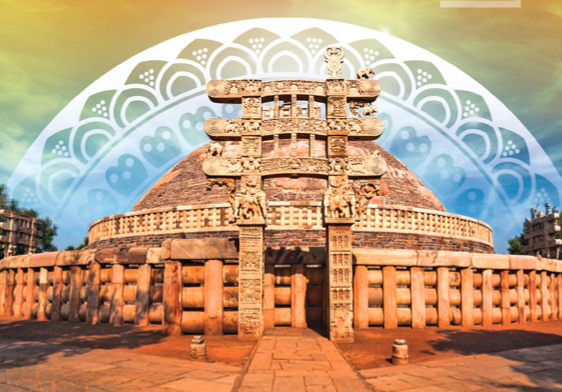
It is a busy day at the market in ancient India! A girl and her mother walk through the stalls in the Gupta city of Mathura. They buy rice, lentils, and grapes. They skip the meat seller, though. Their Buddhist family eats a vegetarian diet.
The girl is especially excited this morning. Later, her family will attend a musical performance. She hopes to hear a musician playing a stringed instrument called a veena. It is her favorite!
Who Were the Ancient Indians?
Ancient India was a period that lasted from around 1500 BCE to 550 CE. Several civilizations ruled the region over time. The largest, the Mauryan Empire, extended over what is now India, Pakistan, Nepal, and Bangladesh. Its population may have reached 30 million people.
India’s name comes from the Indus River. Early Indian settlers used the word sindhu for the waterway. This means “river” in Sanskrit. In the 300s BCE, Greeks began saying Indus instead.
Around 1500 BCE, a group called the Aryans arrived in the Indus Valley. This was the beginning of India’s Vedic period. Early Aryans were nomads. They came to Ancient India from central Asia. Along the Indus and Ganges Rivers, they became farmers! The area had rich soil to farm. Natural resources such as iron helped new villages gain wealth. In time, the villages grew into India’s first kingdoms.
Later, the Mauryan dynasty, a family of rulers, united the kingdoms into one empire. The empire used military force to grow even larger.
Ancient India is best remembered for its advances during the Gupta Empire. The Guptas made important progress in math, science, astronomy, medicine, and writing. The numbers used today come from the Gupta period. The Guptas even invented chess!
In the late 400s CE, a man named Aryabhata studied math and astronomy. He invented the decimal system we still use today. He was also the first person to argue that Earth is round!
How the Ancient Indians Ruled
Ancient India’s government changed with each ruling civilization. Chiefs called rajas led Aryan tribes. Rajas protected their people and cattle from enemies.
By around 650 BCE, Aryan tribes had formed sixteen kingdoms. But the foreign Persian civilization invaded the area in 550 BCE. Two centuries later, Macedonia’s Alexander the Great took control. But Alexander only stayed in India for two years. Soon after he left, the Mauryan Empire took control.
India’s Mauryan Empire began with Chandragupta Maurya. Around 321 BCE, he united India with his powerful army.
The new emperor created a strong government. He built great wealth through war and trade. The Mauryan Empire became one of the largest in the world!
After the Mauryan dynasty fell in 185 BCE, small kingdoms ruled once more. But around 320 CE, a man named Chandragupta I claimed power. His military might helped him found the Gupta dynasty. The Gupta Empire was a peaceful time. It reigned until ancient India’s end.
Daily Life
Society in India’s ancient empires was largely based on daily life during the Vedic period. Early Aryans were largely egalitarian. They believed that all people are equal to one another and have equal rights. But as they settled onto farms, Aryans organized people into four groups. They called these groups varnas. Each varna had its own jobs and rules. Aryans believed varnas led to a peaceful, orderly society. They thought clear rules brought people freedom, or moksha.
After the Vedic period, varnas became known as castes. People were born into their caste. They could not change castes or marry outside of their own. The caste system impacts Indian life even today.
The Caste System
Education changed over time, too. During the Vedic period, both boys and girls went to school. At age 5, boys went to live at school with their teacher, called the guru. The boys studied math, science, writing, and other subjects. Girls studied at home. Many grew up to be community leaders, artists, or priestesses.
After the Vedic period, boys learned different skills based on their caste. But women’s status, rank in society, had fallen. Women could no longer take part in many public activities. Most girls had to stay home to care for children and do chores.
Family was important in ancient India. Usually, the eldest male was the head of the household. Most people lived in one-room huts made of wood or bamboo. Even palaces were made of wood!
Ancient Indians ate a lot of vegetables and grains. Lentils, rice, barley, and beans were staples. People also ate bread, fruits, and a special butter called ghee. Some ate pigs, chickens, or goats. But religions such as Buddhism encouraged people to eat a vegetarian diet.
Beliefs and Culture
Several important religions began in ancient India. The Aryans were deeply religious. The Vedic period is named after their sacred books called the Vedas. The books held songs, prayers, and rituals. These rituals were important for their religion. They taught people to respect all living things. The Vedas’ teachings formed the beginning of the Hindu religion.
Around 560 BCE, a man named Siddhartha Gautama was born a prince in what is now Nepal. He founded a religion called Buddhism. Buddhism taught people to live in the present moment to find peace and truth. Today, Hinduism and Buddhism are among the largest religions in the world.
Much of ancient Indian art was religious. During the Gupta Empire, beautiful Hindu temples were built across the country. These were meant as homes for the gods. Mauryan and Gupta artists painted caves with scenes of the Buddha’s life. Many of these are still there!
Writing became another important art form. Early in ancient India, Sanskrit was mostly used for trade records. But later Vedic writers created some of the first epic poems. The Guptas preserved these poems and saw new poetry and plays develop.
The Fall of Ancient India
The Gupta Empire began to fall in the late 400s CE. Weak leadership shook the empire’s safety and economy. Some regions rebelled and broke away from Gupta control.
A group called the Huns also attacked from central Asia. These fierce warriors first entered India around 450 CE.
By 500, the Huns had captured much of the northwest empire. The Gupta Empire finally ended around 550 CE. It was divided into independent kingdoms once more. Centuries would pass before India united again.
Today, India is a large country of more than 1 billion people. Many Indians continue the practices of their ancestors who lived long ago. Hinduism is India’s largest religion. The caste system also still affects life for many people.
Ancient India also changed life around the world. Billions of people still use India’s numbers and decimals. Buddhism is becoming more popular in Europe and North America. Ancient India’s important legacy lives on in modern India and across the globe!



 About BeeLine
About BeeLine